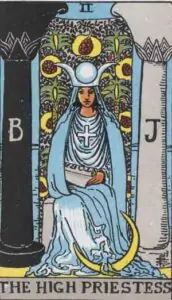In the following Tarot Guide, I will show you how to lay your own cards and reveal your destiny in five easy steps. For the meaning of each card visit the Tarot card section.
A Tarot Reading is a spiritual and even magical ritual and needs time to prepare and follow up.The inner attitude is also crucial. If a Tarot reading is just a game to me, the result will not be much more than a bit of fun and entertainment.
If, on the other hand, I see Tarot as a way to gain insight into the subconscious, into another transcendental world, then messages and predictions will make their way into our consciousness.
Read through The Guide at your leisure and take what seems meaningful and useful to you on your way. Discover the secrets of Tarot.
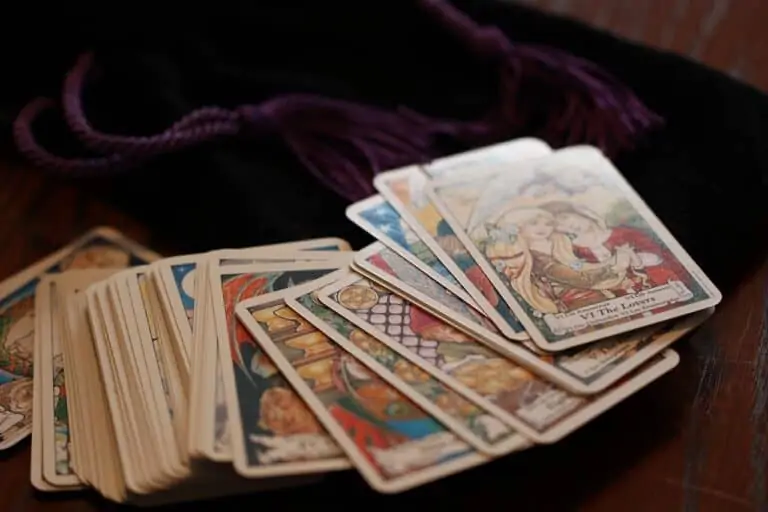
Preparation
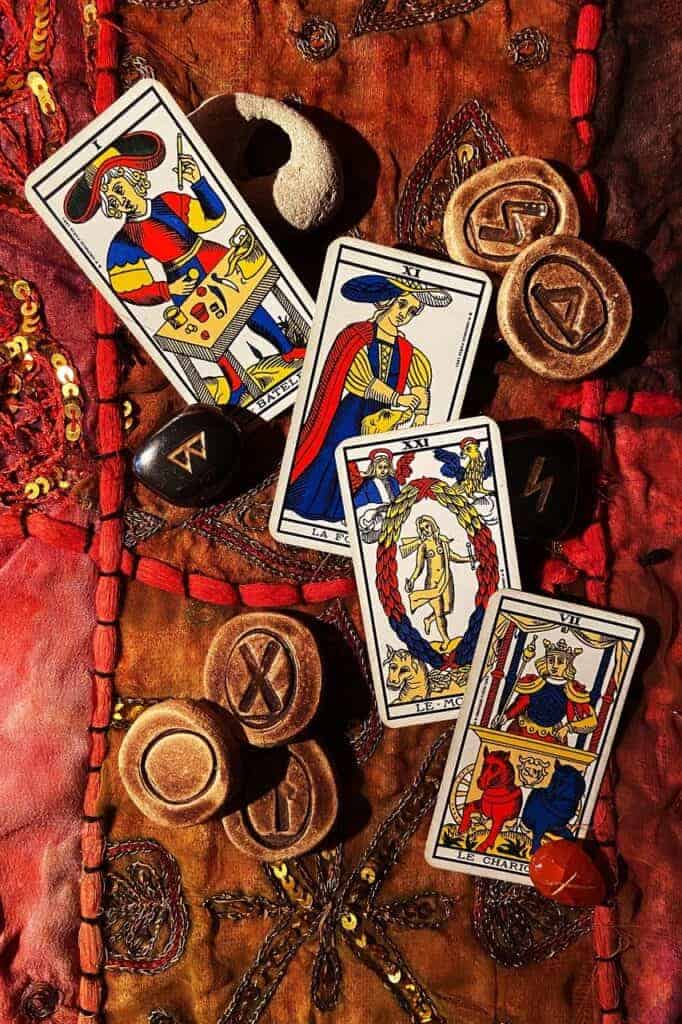
Before you begin to draw the cards, both the outer and inner worlds should be in harmony. This is significant in that the connection to the spiritual world requires a high degree of purity with one’s own spiritual world of thought as well as from external environmental influences.
A Tarot session can best be compared to meditation. When meditating, one strives to immerse oneself completely in the moment and to eliminate all internal and external disturbing influences.
The attitude of mind gained in this way enables new access to one’s own spiritual world and opens one’s consciousness to new experiences.
Therefore, take your time and prepare your Tarot experience well. The more careful and conscious the preparation is, the more impressive will be the results of your interpretations.
Inner Attitude

Our inner spiritual attitude is crucial for a successful Tarot reading. Four different spiritual states are conducive to the Tarot.
Openness: Being open to new experiences means not to immediately evaluate the unknown or unfamiliar things negatively out of fear, but to first just look at and explore the new impressions.
Thus a Tarot card Reading can open completely new perspectives on entrenched problems or thought patterns.
Serenity: Serenity is a state of inner peace and balance. Thus it becomes possible to “hear” our inner voice again.
By being completely with the Tarot and the moment, my consciousness opens up and allows me to perceive thoughts and feelings that have become quiet, making the messages of the Tarot “audible” again.
Focus: The Tarot cards accurately reflect our inner state of mind. The more concrete the focus on a question, the more likely the cards will reveal a solution.
However, if one is easily distracted or perhaps does not want to face a question at all, distraction will spread and have a negative effect on the drawing of the cards.
Gratitude: Respect and gratitude towards the cards and the Tarot ceremony are essential for a successful ritual.
The Tarot cards are important helpers to get in touch with the spiritual world and to decode its messages. The more attentive one is with the cards, the better they will reveal to one the way of the Tarot.
The four states of mind presented are probably not always immediately present, especially at the beginning of your Tarot journey. Take your time and focus only on the openness aspect in a tarot reading.
Over time you will find that the mental qualities develop, the more you work on and with them. The card reading is also possible without the full expression of the mentioned mental states.
However, the revelations of the Tarot become clearer the purer our inner state of mind is.
Outer Environment
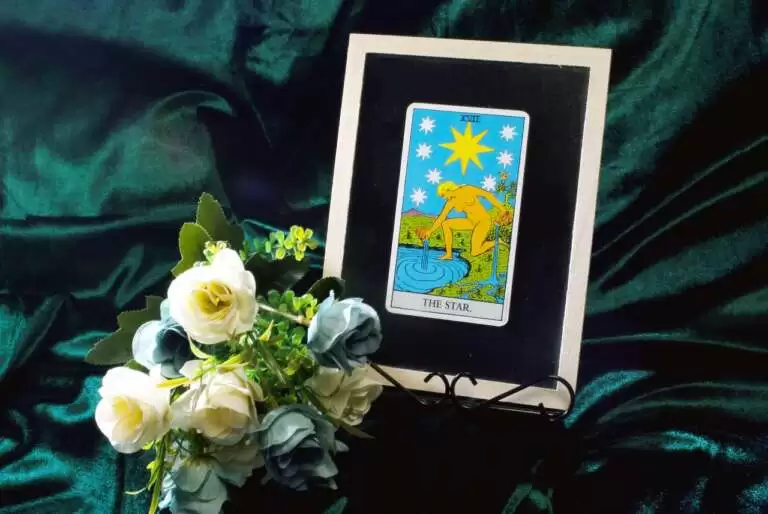
In addition to the inner state of mind, the outer environment plays an important role in a Tarot reading. Inner and outer states influence each other, positively and negatively, and therefore should definitely be taken into account when reading the cards.
The external environment can be adapted to create an effective atmosphere and energy, allowing the tarot reading to reach its full potential. Below are some helpful suggestions to harmonize your environment.
Location of the card reading: Choose your location for the card reading carefully and design it accordingly. It is advisable to always use the same room, if possible, to create energy channels there and to strengthen them further through regular practice.
You should feel comfortable in the chosen place and be able to come to rest. Contrary to what is portrayed in many movies, the room should not be a dark or a small cellar niche. But it should be rather bright, inviting and with contact to the outside world (e.g. through a window or a balcony door).
If no separate room is available, it is just as well to set up a small compartment, e.g. in the living room. Make sure that as little electrical media as possible is in direct view and that the compartment is well separated from the rest of the room, for example by a chest of drawers.
Remove unnecessary objects that could cause distraction and always keep the place clean. Over time, you will automatically get a feel for your Tarot location and notice how soothing and relaxing the reading of the cards feels.
Often people close to you will also sense the energies emanating from your Tarot location and feel a similar kind of serenity.
Arrangement of the place: Arrange the place according to your wishes and needs. Objects to which you have a particularly deep positive connection, should in any case get their place in the room.
These can be objects that you took on vacation as a souvenir, but also self-painted pictures or sculptures are wonderful for furnishing and positive energy building. For example, a small table on which the tarot reading takes place can also serve as an altar.
Use as many natural materials as possible, such as wood or silk, as these are more suitable to focus energies that arise during the Tarot. Also make sure to use as calm colors as possible in the design of your place, which will help you to focus completely on the card reading.
When setting up, the old adage “less is sometimes more” is recommended so that there are no distractions during the tarot reading.
Cards: Get a deck of Tarot cards that is exclusively for you. For starters, I recommend Tarot cards with the symbols of the Raider White Tarot. With increasing practice of card reading, the unleashed energies will manifest more and more in your cards, so that future divinations will gain significantly in precision and clarity.
Handle your deck of cards very carefully and make sure they are clean and whole. If one or more cards are damaged, it is better to buy new Tarot cards. The cards in a set are matched to each other and lose much of their acquired energy when individual cards are replaced.
To keep your cards undamaged, you should get a card container so that you can also take your cards to other places or on vacation.
After you have harmonized both the inner and the outer world, you can start laying the cards.
Drawing The Tarot Cards

Once the inner and outer preparations are completed to your satisfaction, the card reading begins. In the Tarot, the drawing of the cards is a very exciting, energetic process in which we gain access to divination through the Tarot cards.
Card drawing in tarot is a procedure that can be divided into some intermediate steps. With practice, the drawing of the cards will feel natural and free. At the beginning, however, it is recommended to feel and try out the individual steps very carefully.
Which energies do I already perceive when shuffling the cards? How does the first drawn card feel? What do the cards reveal to me?
Answers to these questions are given in the next sections.
Question

Everything begins with a question. The Tarot cards are consulted to gain insight into issues important to us.
However, we should take some time already when formulating the question and think carefully about our expectations regarding the cards’ answers. To get a helpful answer, it is advisable to let your mind wander over the problem before the cards are read:
– Does the question concern only me or are there other people involved?
– To what extent does the answer affect my further actions?
– Have I considered all points of view?
The way we ask a question is crucial. The Tarot cards do not tell us directly what to do specifically but expand our awareness in terms of new perspectives on the problem and solution.
For example, yes or no questions tend to hinder card reading, since the cards always reveal multiple perspectives related to a question.
Take a close look at the following questions as examples:
– Should I change my job?
– What are the perspectives of changing employers?
In the first question, an important decision is ceded to the cards to avoid one’s own responsibility. In the second question, there are many more possible answers that I can use for my own decisions.
This has the advantage that I increasingly learn to trust my own decisions and not live externally determined. The following points when formulating the question, help to better understand the answer received through the tarot reading:
1. Formulate questions best openly for example beginning with What, Which, How.
2. Avoid yes-no questions or questions about specific points in time, e.g. When will I get married?
3. Find a good balance regarding the concreteness of the question, not too specific not too global
4. Phrase questions in a positive way, instead of: Why do I never get a job? to What do I need to change to get more job offers?
5. The question should always be about you and your options, even if the question is about another person.
After you have formulated your question accordingly, write it down exactly like that. In Tarot, single words that are added or omitted afterward can change the answer of the cards. You can also lay the cards without a specific question.
Another way to use Tarot for yourself is the free Tarot card reading. Here there is no specific question, rather you are guided by your intuition, which topic has priority in your life.
The free card drawing is best used on very special occasions, such as a marriage, birth of a child or a change of residence or job. Challenges or opportunities lying in the future can be recognized in time.
Such tarot sessions often have a high energy level and therefore require a particularly high level of concentration and focus.
Card Shuffling
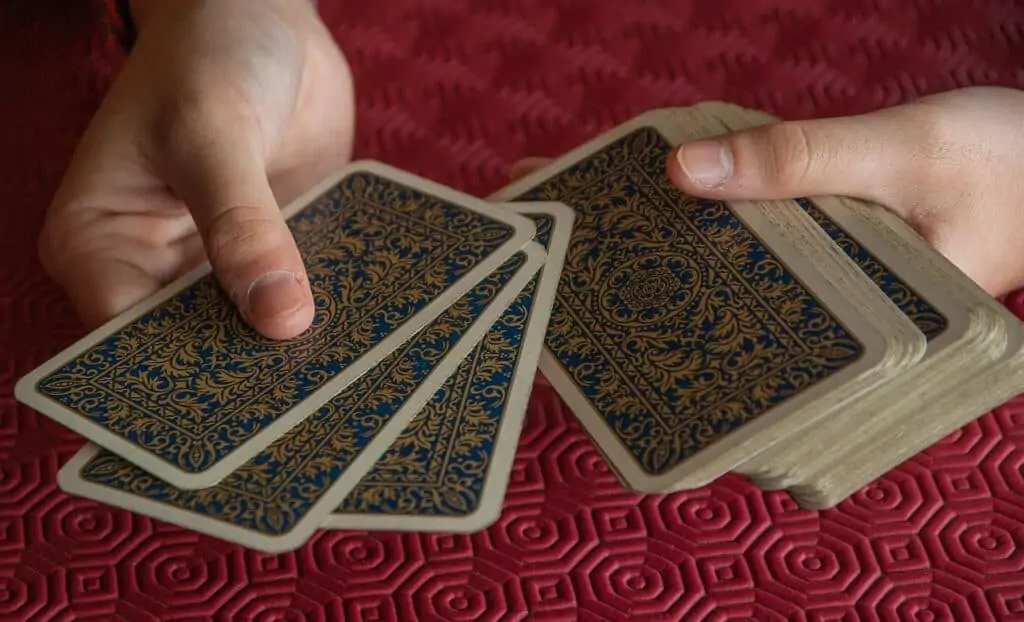
Before the cards are laid, go to your tarot location and try to fully engage with the upcoming moment. In the beginning, meditation or prayer can be very helpful to tune into the energies of the ritual and to achieve inner calmness.
When you feel ready, take your cards out of your container and hold them in your hands for a moment. Meanwhile, let your question flow into the cards by repeating it in your mind a few times. Now shuffle the cards. There are different techniques for this. A simple method is described below:
1. Divide the cards into two piles.
2. Hold both piles on the inside with your thumb, lift them a little and push the lower cards a little closer together.
3. Then let the cards fall down piece by piece so that both decks mix.
4. From the resulting pile, lift a smaller one and place it to the left of the original pile.
5.From the smaller pile, pick up a few cards and place them to the left again.
6.Now put the piles together again, don’t think about which pile you take first, but trust your intuition.
The Tarot Spread

Now the cards are placed according to the previously selected spread. There are many Tarot spreads, some requiring only one card and others including all 78 cards of the Tarot. Accordingly, more or less complex issues can be addressed.
For the daily tarot reading, one to three cards are enough to start with. With three cards, you can simply lay three cards next to each other from left to right at the beginning. Note, however, that with such a small number of cards very complex questions can only be partially answered.
The more experienced you become with the drawing of the Tarot cards, the more complex can be the laying systems with which you work. Nevertheless, I recommend that you try the Celtic Cross spread at least once a week, especially in the first sessions.
The Celtic Cross is by far the most popular Tarot spread and consists of ten cards arranged in a special shape. As you can see in the picture, the Celtic Corss consists of a cross on the left side and a staff on the right side.
In the section, Free Tarot card Reading is once again a detailed summary of the Celtic cross with the individual meanings of the position of the cards.
For the beginning, the three-card tarot is particularly suitable. Here there are three positions, each of which can have different meanings. Which meanings they have depends on your question.
Below is a table that you can use to choose the appropriate meaning of the positions of the three-card tarot to match your question.
| Position 1 | Position 2 | Position 3 |
| Situation | Action | Result |
| Myself | The Other | Relationship |
| Past | Present | Future |
| Thinking | Feeling | Acting |
After you have decided on a spread and shuffled the cards accordingly, the drawing of the cards can begin. Keep an attentive mind during the card reading and observe your thoughts and feelings carefully.
Now draw the top card from the deck and place it in the first position according to the spread. While you turn the card over and put it in its place, you will feel what energy suddenly develops.
Sometimes the first card drawn is enough to answer your question or problem. In this case, you can still lay the rest of the cards, but trust your inner voice and weigh the first card the most.
Place all the cards one by one on their corresponding position until all of them are occupied. If some of the cards are upside down, you can turn them “right” again. Reversed cards have their own meaning, which you can apply to your tarot ritual as you gain experience.
Once you have distributed all the cards to their positions, let all the Tarot cards work on you. Ask yourself the following questions:
– What thoughts and feelings arise when you look at the cards?
– Are there spontaneous spiritual impulses when looking at single or combined cards?
– How do the individual positions of the cards affect your question?
Take the time to write down some of your ideas and thoughts. These can help you to reflect on your Tarot session and gain new insights.
The more time you invest at the beginning for such analyses, the less time you will need later to clearly structure your findings after the card reading.
The next chapter is about card interpretation.
Tarot Card Reading

After the cards are laid out face-up, the interpretation of the Tarot cards begins. First, you need to be aware of the meaning of each card. After some time, you will immediately recognize the individual meanings of the Tarot cards.
However, not only the meaning of individual cards is important, but also the combination of several cards. Here it takes a lot of practice to be able to intuitively interpret appropriate combinations of the cards.
With daily practice, your awareness of the meaning of the cards will continue to sharpen and eventually become flesh and blood, so that you can focus more and more on your inner voice. The following describes how you can best interpret individual cards and card combinations.
Single Tarot Cards
The interpretation of the Tarot cards includes on the one hand the content of the individual card or all cards laid as a whole picture to look at. Between these two perspectives, there is a constant back and forth during the Tarot ritual to open up the divination of the cards.
As a guide to interpretation, use the following four levels of interpretation of the cards, to gain as much insight as possible from the individual cards. Based on the Three Card Tarot (for the values past/present/future) the individual levels are explained again with examples.
First Intuition: This level contains the first feeling you feel when the respective Tarot card is laid out. With each card that is revealed, our inner voice reacts and shows us spontaneously how important this card is for us.
With the Three Card Tarot, you should pay close attention to your intuition.
In the beginning, you may only feel a slight tingling or a slight feeling of tension. With practice, your senses will sharpen and the physical and mental signals will become correspondingly stronger.
If you feel a stronger sensation in the third position, you should especially direct your focus on the future. Or, through the card, consider future recommendations for action more than past or present actions.
The described spiritual insight is very individual and can be different for each person despite the same question and position of the cards. Depending on our personal life history and our own thoughts and feelings, we will react differently to the cards.
Meaning of the cards: The second level includes the attributed meaning of the cards. The meanings of the individual cards are not uniformly regulated and differ depending on the fortune teller/tarot legend. It is important to choose your own interpretation system and to practice it.
In the Tarot Card Meanings List, the meanings of each type as used on this website are described. The 22 cards of the major arcana and the 56 cards of the minor arcana are analyzed in detail and described with helpful interpretations.
The memorization of the theoretical meanings of the cards will be trained all by itself with practice. Once the meanings are automated, you can concentrate more on your inner voice and feel which spiritual message the individual card contains.
Position of the card: On this level, you will deal with the position of the card in the respective Tarot spread. Be aware that depending on the Tarot spread, the meaning of the cards may change to the initial question.

Let’s stay with the Three Card Tarot and look at the possible meanings (we start from the upright card position) of the Five of Swords for the respective positions to the question about our current love relationship.
If the Five of Swords card appears in the first position, it means that we have been too attached to relationships in the past and want to save them at any cost. In the second position, the card reveals that we are currently too stuck in a very conflictual relationship and want to dominate here at any cost.
The third position reveals future events, where the Five of Swords can predict upcoming conflicts or warn against trying to win over a partner at any cost.
Please note that these examples are only very vague and depend on your concrete question or your current situation in the field of love. The interpretation of the cards should be adjusted accordingly.
Questioning and living conditions: The own questioning and living conditions play a decisive role in the Tarot. Depending on the question, a card reveals different practical recommendations for action.
For example, if the cards are asked about a new relationship or an analysis for a long-standing partnership that has grown, the divination often turns out differently, although the same card was drawn. In the case of the Five of Swords, for a new relationship, it can mean that too much energy is sacrificed to keep the young love alive at the expense of all parties.
For an already long-standing relationship, the Five of Swords card can indicate that the relationship is currently too conflict-ridden and thus perceived as suffering. Our own living conditions include our world of thoughts and feelings, which has been formed mainly due to experiences made in the past.
Using our example with the Five of Swords and the question of a new relationship, the interpretation depends on our biography.
Someone who has little relationship experience should be careful when drawing this card not to sacrifice his whole life to a current love relationship but instead practice patience.
For a person who already has a lot of relationship experience, on the other hand, it can mean to question one’s own conflict behavior in relationships.
Tarot Card Combinations

Interpreting individual cards is an exciting process in itself, but is greatly enhanced when the relationship of the cards to each other is taken into consideration. Tarot consists of a total of 78 cards, which can be used in their entirety depending on the spread system.
Even in the Celtic Cross, there are countless different combinations of the cards in the ten different positions, so that each Tarot reading always reveals a new surprise. Even in the Three Card Tarot, there are 456456 different combinations of cards.
Thus, there is also not for each card combination a corresponding interpretation. Only a lot of practice and patience let us become more confident in interpreting the entire tarot picture. However, there are combinations of cards that occur somewhat more frequently and are discussed in the following sections.
Major vs. Minor Arcana Cards
A Tarot card deck (according to Raider White) consists of a total of 78 Tarot cards, of which 22 are assigned to the Major Arcana and 56 to the Minor Arcana. Two cards of each different Arcana can have similar meanings, such as the Hermit and the Eight of Pentacles.
The Hermit represents purposefulness and self-discovery and symbolizes the search for inner truth. If this card is drawn, it may indicate that one is searching for deeper answers or causes for or to certain life events.
Such a search or quest for answers can lead one to question and change previously chosen life goals or habits. Thus, the characteristic of a Major Arcana is that it affects major aspects of one’s life for a longer period of time and is not just a short “phase” of change.
The Eight of Pentacles has a similar meaning to the Hermit but is much more limited in scope and duration than a Major Arcana card. It becomes interesting when a Minor Arcana card is drawn for a particular question in a Tarot session and a Major Arcana card is drawn later in the same position and for the same question.
This can indicate a development, for example, when an initial good friendship develops into a partnership. Therefore, it is very important to note the individual cards and positions after you have laid the Tarot cards and to compare them over time for important recurring questions (see fade out).
Card pairs
Opposing pairs
During the card reading, it can sometimes happen that two cards with opposite meanings appear. Drawing such cards in a session can be an important indication that one’s mind is swinging back and forth between two extreme positions and that there is a need to balance the opposites.
The opposite cards can likewise indicate a conflict between two people who are very contrary in certain attitudes towards each other. While it may seem tempting, especially at first, to reshuffle the Tarot cards when such opposing meanings are present.
However, you are forfeiting the chance to gain a deeper understanding of the Tarot cards. Two of the most popular opposing cards are the Magician and the High Priestess. 
The Magician represents activity and our everyday consciousness. The High Priestess, on the other hand, represents a wait-and-see, non-active attitude as well as a focus on the subconscious.
At first glance, both cards form two extremes that seem incompatible. At a second glance, it becomes clear that the two cards are only different sides of the same coin and cannot exist without each other.
And for this reason, two opposite cards give us the chance to look deeper behind our question or future and to grow from the revelation.
Reinforcing pairs
Cards can also reinforce each other in meaning when they share the same characteristics. This is often a sign to follow the revealed solution path and quickly align one’s actions accordingly.
Depending on the Tarot spread, such cards can point to a previously ignored energetic aspect, which opens up new opportunities and perspectives for the questioner. Your own inner feeling plays an important role here.
If another card is perceived as more important in the spread system, the strengthening pairs should only be interpreted secondarily.
Such pairs often appear unexpectedly, in situations where you have already tried many ways without being satisfied with the result. Reinforcing pairs encourage us to take unfamiliar paths and open ourselves to new approaches and ideas.
The individual cards in the Tarot do not stand alone, but always in relation to the other cards that are laid. The Tarot dialogue unfolds only through the complete laying and interpretation of the cards, which will be discussed in detail in the next chapter Tarot Revelation.
Tarot Revelation

The interpretation of the Tarot cards is a very impressive and spiritual moment. However, relying only on the theoretical meanings of the cards or card combinations ignores the greatest potential that Tarot offers: one’s own Tarot wisdom.
In it, the individual meanings of the cards play a role only insofar as they give us access to our own inner source of wisdom. This source has unlimited creative power and level of revelation.
To experience inner wisdom means at the same time to be connected for a short moment with the whole cosmos beyond spatial and temporal boundaries.
The Tarot cards offer us as a medium the possibility to touch this source and to draw strength and energy from it. They are a tool through which we can perceive our inner voice more strongly.
This inner voice gains more and more importance over time so that the divinations in a Tarot reading become more and more precise and rich.
But how do I create or recognize the meaning behind the Tarot cards?
Don’t I need an experienced teacher for that?
What do I do with the knowledge I have gained?
These questions are answered in the following chapter. A few example stories from the Three Card Tarot are explained.
The Tarot Wisdom
Wisdom or Knowledge in Tarot has two levels. On the one hand, the intellectual level, which has already been discussed in the chapter on card interpretation. On the other hand, a deeper spiritual knowledge comes from ourselves. Intellectual insight is only the preliminary stage to the second level.
With increasing experience in card reading and the development of one’s own inner attentiveness, it will recede further and further into the background in favor of the spiritual level. The spiritual level includes three main characteristics:
1. Inner Peace: This refers to being completely absorbed in the present moment. You feel each card not only with your hands and eyes but with your whole body. You will gradually forget the time and space you are in. You will feel many emotions and thoughts, but you will still be able to fully engage with the Tarot cards.
2. Mindfulness: Every thought and emotion will be closely observed by you. Which feeling is trying to push itself to the fore? Which thought is making its way from the depths of the subconscious to the surface? Do not dwell too long on any thoughts or feelings, but observe them.
3. Spontaneity: This process refers to experiencing and expressing various emotions or cognitions, which arise only by looking at and revealing the Tarot cards. Often this process transfers to the body, as our conscious mind cannot process the subconscious as quickly and the latter tries to express itself through the body.
This can range from a small smile to a loud cry of joy. Every emotion is conceivable and desirable here, as it shows us in which direction we should orient ourselves.
Take a break if you are overwhelmed by a very strong feeling and observe your thoughts. Try to bring yourself back into harmony with the tarot session and continue to lay the cards.
Spiritual insight comes from our subconscious mind. Messages from the subconscious are difficult to reach the surface of the comprehensible. Tarot card reading offers our subconscious the possibility to let us perceive insights through the cards.
Here, as already mentioned, the structured Tarot spreads and meanings of the individual cards can help with the interpretation. Our main focus, however, should always be on our inner voice, which contacts us through the Tarot cards. The communication with our inner voice is presented below as a Tarot Dialogue.
The Tarot Dialogue

The Tarot Dialogue is the technique that can help us to gain deeper insight into the placed cards with the help of the theoretical meanings of the Tarot cards. The Tarot Dialogue can be applied in three steps as follows
1. Communication with the cards: Talk to the cards. Call the placed card several times by its name. Be aware of the meaning of the card (as a beginner you can look up the meaning of the card in the Tarot Card Meanings List).
By constantly repeating the card and its meaning in the back of your mind, we create a direct communication path to our subconscious. You can then continue to recite the card’s meaning to yourself out loud and wait for a response from the cards.
2. Answer from the cards: With some cards, you will notice how suddenly thoughts or emotions arise in you that seem to come out of nowhere. This is exactly the answer from our subconscious that reveals deep and instructive insights.
Not all cards will give you such an answer. If you are still a beginner, you will not get much response from the Tarot cards as someone who has already laid 10000 Tarot cards.
Even a lack of an answer in a Tarot reading can be an important building block for gaining knowledge. Because some cards are not so important in their meaning compared to others at the moment and can remain unnoticed.
Spontaneous expression: Try to express yourself spontaneously with your whole body via the cards. For example, if you experience a sudden feeling of joy, just laugh out loud or smile.
Depending on how strong your impulse for a card is, you will recognize what weighting in your Tarot knowledge this card has. Depending on the reading system, a certain combination of cards can also trigger a strong feeling in us. Therefore, it is always worthwhile to look away from the individual cards to the big picture.
The Tarot Dialogue will develop and intensify itself with advancing experience. You mustn’t put pressure on yourself if the Tarot cards do not reveal everything at the beginning.
Keep practicing, keep learning, keep opening up, and the dialogue with the cards will unfold all by itself.
Example of the Three Card Tarot

The following section uses an example of the Three Card Tarot to show how insight can be gained from the cards with the help of the Tarot dialogue. The example is about a friend who wanted to know why her relationships with a partner were so short-lived.
We used the Three Card Tarot with the positions 1st card: Past, 2nd card: Present, 3rd card: Future. Thus, we wanted to gain insight into how the relationship problems arose, what keeps them going, and how to solve them in the future.
Since she was a very close friend of mine, I knew many important details of her life and relationships that helped us to understand the Tarot cards.
My friend laid the cards herself. I only accompanied the session and recorded her experience, so that she could fully concentrate on the card reading.
The following tarot dialogue and the knowledge gained from it made her on the respective positions:
Position (Past): In the first position, the card Three of Swords appeared. The Three of Swords represents a broken heart or the painful experience of having been betrayed, both by oneself and by another person.
The dialogue with the Tarot card unfolded all by itself. My friend sighed heavily and had to take several deep breaths before she could continue laying the cards.
At that moment, all the love relationships that were important to her went through her mind. Every time she thought it was the love of her life, she was betrayed or abandoned by her partner.
Because of these painful experiences, which happened very early in her life, she became very cautious in her choice of partners and could not get involved in deeper relationships.
So she often ended later partnerships after a short time by herself. By that, she did not have to experience the feeling of abandonment again.
Position (Present): The Queen of Cups appeared as the next card. At this moment, my friend paused and repeated the card’s name several times and became aware of its meaning. After a while, she began to smile and her eyes became a little moist.
The Queen of Cups represents, among other things, a big heart and a sense of other people’s feelings. My friend could identify well with the card because she cares a lot about other people and has a big heart for their needs.
At the same time, the card made her aware that she sometimes sacrifices herself in relationships with other persons and overlooks her own needs in the process.
With this realization, she had gained an important hint for herself on how to take more care of herself in the here and now.
Position (Future): The last card drawn was the Star. This card belongs to the Major Arcana and took a special weight in the Tarot session in terms of its significance.
The card stands for hope and inner strength. Before the last card, it seemed very tense, the third position is, after all, an indication of the future at hand.
When the Star appeared, my friend visibly relaxed, her whole body calmed down and her breathing became much slower.
She felt that she has the inner strength to finally find her True love and not to give up hope. Later my friend told me that she had already felt this inner power before the tarot session, but only after the card reading, she dare to accept this power.
This example illustrates how complex the interpretation of the Tarot cards can be and what valuable insights can be gained from the cards.
If you are just starting with Tarot card reading, you may not yet experience such complex dialogues in a Tarot session.
Possibly it is at first only a quiet whisper of your inner voice, only individual words or diffuse feelings that you experience during your first tarot sessions. Just leave yourself enough time and space to make your experiences with the cards.
It is best to start with a Daily Tarot card, which consists of only one card and see how this card reveals itself during the day.
Then experiment with more complex spreads and let the Tarot Dialogue unfold naturally. The final chapter on getting started with the Tarot covers the Ending of a Tarot card reading.
The Ending

Congratulations if you have made it to this last section! After you have laid the cards and entered into dialogue with your inner voice through them, the tarot session will end.
This is an important step to bring the created energies of the Tarot back into harmony so that they do not influence the next card reading.
If the energies are not cleansed after a tarot session, they will remain in the cards or in the place where the cards were read for a long time and will become more and more difficult to remove.
The following section shows how you can quickly and easily cleanse your place after a Tarot reading and prepare it for the next session.
Then there is an overview of how with the help of a journal your understanding of the Tarot can be further strengthened and new insights will result for you.
In the last part of this chapter, some general suggestions for your further Tarot path are given. I hope you feel strengthened to go your own way in Tarot and card reading and to fathom the secrets that rest within you.
Ending the Tarot Ritual

The cards have been laid and the Tarot Dialogue/wisdom has taken place. As with any ritual, it still needs the right ending to have enough energy in the cards again for the next session.
Before you remove the cards from their positions, write down the placed cards in the exact position (see Tarot Journal). Then take the cards back in your hand, starting from the last position, and look at each one again separately.
Feel what message each card had for itself and what Tarot dialogue had resulted with the cards laid. Thank the cards and your inner voice for the insights and knowledge they have given you.
This attitude of gratitude and humility is an important basis for further tarot sessions, as your own inner attitude is the key to your subconscious.
Now shuffle the cards again completely. Here you can use the same shuffling technique as at the beginning of the tarot session.
When you feel that the Tarot cards have been shuffled enough, put them back into their container and keep them safe. Your tarot place should also be left clean and tidy.
Before leaving the tarot place, you can do some meditation or yoga exercises. Both help to harmonize the energies that arise during a tarot session and to bring the inner and outer world into harmony. Thus the circle closes – you end in the Tarot as you began.
Often it happens after an intensive session that many thoughts and feelings, which have arisen during the card reading, accompany you throughout the day. This in itself is a good sign, as it shows that your inner voice wants to tell you something urgent.
Sometimes these emotions and cognitions can hinder your daily life. In this case, try to stop your thoughts by mindfully breathing in and out.
Talk to your feelings and thoughts, acknowledging that they want to help you and point out something important, but that you need some time for other things right now and will come back to them later.
Often through this technique the thoughts and emotions disappear or reduce by themselves. But you should not forget to give them space again later, as you promised.
The intensive occupation with them for only 10 – 15 minutes will also reduce recurring thoughts. In the next tarot session, you should have a clear mind and are not distracted by previous card readings.
The Tarot Journal

An effective way to deepen your tarot knowledge and insight is to systematically summarize your Tarot sessions in a Tarot Journal. This way you can follow your own development concerning Tarot card reading over time and learn to trust your own intuition more and more.
In addition, difficult or intense sessions can be reviewed in retrospect. Below are some suggestions on what to include in your Tarot Journal and how it should be structured. Feel free to use the ideas given or be inspired to come up with your own ideas for a Tarot Journal.
External Factors: This mainly refers to the date, the location and the spread system. The date is important to look at your own progress, or how the answer of the cards in a tarot reading may change over time to a particular question.
Tarot is a very dynamic process and the cards reveal their messages depending on our experiences. To be able to observe this dynamic and use it for gaining knowledge, it is very instructive to look at the cards over a period of time.
The place of the Tarot reading should be noted if it is not at your typical Tarot location. This can be on vacation, for example, or at a friend’s or relative’s home.
The Tarot insight can vary greatly in clarity and intensity, depending on the location. For example, if it is very difficult to lay Tarot cards with friends, it would be worth considering moving the Tarot sessions home.
The used Tarot spread should also be noted because depending on the laying system, the position of the cards can have an important meaning regarding the interpretation of the cards. You can also observe how Tarot Dialogues change depending on which spread was used.
Among the external factors are also important life events that you are currently very busy with. Such events significantly influence communication with our subconscious.
The Question: Write down your question as precisely as possible. Especially in a daily Tarot card reading, similar questions often reoccur. But the answers vary in complexity and content depending on the reading system.
You will notice that rather simple questions fit simple spreads and difficult questions to more complex spreads. In addition, you will quickly recognize which Tarot spreads feel good to you about your questions and leave room for your intuition. You should continue to keep these.
The Insight: This point includes which cards were drawn and how the Tarot Dialogue unfolded. It is best to note the cards in the exact position and whether they appeared upright or reversed.
Then describe what thoughts and feelings arose during the session and how your dialogue with the cards unfolded.
Your mental and physical sensations should be noted. In this way, you will gradually develop a sense of your inner voice and its expressions, and your insights from the Tarot reading will deepen.
Suggestions For Your Further Way In Tarot

If you have worked your way up to this point, you will hopefully have learned many new and interesting things about a Tarot reading.
The many individual steps can be very complex, especially in the beginning. After each tarot session, you will notice that the individual steps become more and more routine.
After a while, the process will feel natural without thinking about it. For this, it is important to practice regularly with simple spreads.
Do not put too much pressure on yourself. If you only manage to read the cards once a week, in the beginning, that’s fine.
It is more important that you use this Tarot guide as an orientation to gain more routine and confidence in laying and interpreting the cards. Soon the ritual and the meaning of the cards will automatically appear in your mind during the tarot session.
You can then begin to let your intuition guide you. The dialogue with the Tarot cards will unfold on its own.
Of course, you can also develop your own ritual to communicate with the cards, just trust your inner voice and let it guide you into the world of the Tarot.
When you have mastered the meaning of the cards, you can gradually begin to lay the cards for other people.
You should start with people close to you because you already know them well and have a good intuition about their inner feelings.
It is also recommended to keep a tarot journal with other people to improve yourself further. Tarot card reading for others requires a high level of empathy and concentration.
Both are skills that are practiced well in daily tarot practice. Discuss the meaning of the cards and their positions with your counterpart and together unfold a dialogue about the Tarot cards.

